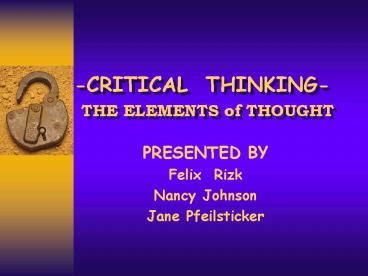CRITICAL THINKING THE ELEMENTS of THOUGHT - PowerPoint PPT Presentation
1 / 29
Title:
CRITICAL THINKING THE ELEMENTS of THOUGHT
Description:
Is a circle an appropriate geometric model for the elements? Is there a particular preference where to ... View all sides of painful or controversial topics ... – PowerPoint PPT presentation
Number of Views:777
Avg rating:3.0/5.0
Title: CRITICAL THINKING THE ELEMENTS of THOUGHT
1
-CRITICAL THINKING- THE ELEMENTS of THOUGHT
- PRESENTED BY
- Felix Rizk
- Nancy Johnson
- Jane Pfeilsticker
2
Elements of Thought
- Where is the thinking?
- Critical Thinker?
3
Elements of Thought
- What are we doing with our minds?
4
Elements of Thought
- What factors are involved holistically?
5
Elements of Thought
- What factors are involved holistically?
6
8 ELEMENTS OF THOUGHT
- Is a circle an appropriate geometric model for
the elements? - Is there a particular preference where to begin
your thought process? That is, can you begin in
any sector and still maintain coherence?
7
LINEAR THOUGHT ELEMENTS
- The best element to start with is Purpose in a
question format. What am I trying to accomplish? - What Question (s) am I addressing?
8
LINEAR THOUGHT ELEMENTS (Contd)
- Next is Information what information do I have
or need to answer the question? - Then, you make Inferences to reach a
Conclusion. - Do my conclusions fit into an established concept?
9
LINEAR THOUGHT ELEMENTS (Contd)
- What assumptions have lead me to that conclusion?
- Are there implications from my conclusions and
assumptions? - Are there alternate points of view regarding this
conclusion?
10
Elements of Thought
- AT WHAT STAGE OF THINKING ARE YOU?
11
Keys to Unlocking the Mind
- Intellectual Standards
12
Check the quality of reasoning
- Clarity
- Accuracy
- Precision
- Relevance
- Depth and Breadth
- Logic
13
Check the quality of reasoning
- This is not an exhaustive list.
- Other intellectual standards include
- Plausibility
- Significance
- Practicality
- Fairness . . .
14
Reasoning with a purpose Good Reasoning
Bad Reasoning
- States purpose clearly
- Relates multiple purposes consistently to goal
- Constructs realistic and significant purposes and
goals - Demonstrates unity of purpose
- States central purpose unclearly
- Switches between different, often contradictory,
purposes - Constructs unrealistic and/or trivial purposes
and goals - Negates own stated purposes and goals
15
Critical Thinking is thinking done well
- More than higher order thinkingProvides
framework for assessing - the value of opinions of others.
- the difference between legitimate reasoning
supported by evidence and an assertion of the
truth.
16
Intellectual Traits
- The results gained from practicing critical
thinking - Obstacles to attaining the Intellectual Traits
17
Intellectual Traits
- Intellectual Humility
- Intellectual Autonomy
- Intellectual Integrity
- Intellectual Courage
- Intellectual Perseverance
- Confidence in Reason
- Intellectual Empathy
- Fair-mindedness
18
Intellectual Humility
- Acknowledging limits of ones knowledge
- Sensitivity to bias, prejudice and viewpoint
limitations - Claiming only true knowledge
- Relinquishing of intellectual pretentiousness
19
Intellectual Courage
- Face ideas and viewpoints that evoke negative
responses - Face and consider viewpoints considered dangerous
or absurd - View all sides of painful or controversial topics
- Attain the courage to be true to ones own
thinking
20
Intellectual Empathy
- Focus on the situation of opponents and others
- Identify with differing viewpoints
- Reconstruct the reasoning of others
- Recall personal parallel situations
- Respect and analyze all viewpoints
21
Intellectual Integrity
- Adherence to ones own thinking
- Consistency in thinking and effecting thoughts
- Holding ones self to identical standards to
which others are held - Honestly admitting ones mistakes or
discrepancies of thought and action - Ensuring consistency between thought,
discussions, and action
22
Intellectual Perseverance
- Continual support for intellectual approach to
problem solving - Firm adherence to rational principles despite
irrational opposition - Insistence on clarity in confusing situations
- Willingness to spend sufficient time with a
problem to determine a rational solution
23
Faith in Reason
- Faith that humankind WILL be best served by
reason - Ones own higher interests will be best fulfilled
by reason - All people can and will come to rational
solutions to problems given sufficient
opportunity to do so - All people possess the capacity to explore
differing viewpoints and reach rational
conclusions
24
Fairmindedness
- Examining all viewpoints equally
- Suppressing ones own reference point in order to
view those of others - Ignoring ones own vested interests in order to
view all possibilities - Adherence to intellectual standards above ones
own interests
25
Obstacles to attaining the Intellectual Traits
- EGOCENTRIC THINKING
26
Hallmarks of Egocentric Thinking
- Autopilot thinking or Reactionary thinking
- It is true because I believe it to be true
- It is true because WE believe it to be true
- It is true because it has always been this way
- It is true because it is in my best interest for
it to be true - SELFISH THINKING
27
Choose to control actions
- We cannot chose our thoughts
- We must choose the thoughts upon which we will act
28
Steps toward Improvement
- Listen to advice of others
- Pause to think before reacting
- Examine personal value of truth
- Examine personal consistency of thoughts, and
actions - THINK ABOUT YOUR THINKING
29
Critical Thinking in the Classroom
- Discuss elements, standards and traits
- Use standards as grading criteria
- EXEMPLIFY CRITICAL THINKING BY DISPLAYING THE
TRAITS






























